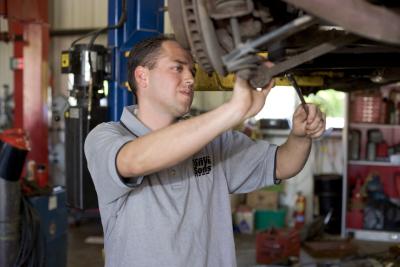
Checking the hub bearings on your car will save you money in repairs and keep you from having an accident or breakdown when a bad hub fails. The hubs on most newer cars are sealed assemblies, but they still contain bearings that will wear over time. Symptoms of a worn bearing can include grinding noises coming from the front end, vibrations in the front that you can feel through the car and steering, and sometimes clunking or clicking noises. If you think you have a bad hub, check it right away.
Raise the front of the vehicle using a good floor jack. You only need to get the tire off the ground about three or four inches to check the hubs.
Support the vehicle on a set of jack stands under the chassis. Make sure it is on level ground and a solid surface so that the stands do not move, shift or sink into the ground.
Grasp the tire with your hands at the 9 o'clock and 3 o'clock positions. Gently apply pressure, first to the front and then to the back, and note if there is any movement in the hub.
Grasp the tire at 12 o'clock and 6 o'clock and again apply gentle pressure, noting again if there is any movement in the hub. Remember that you are not trying to turn the steering knuckle behind the wheel, just check for some movement.
Spin the tire slowly and listen for any grinding noises that may be coming out of the hub behind the wheel. It is sometimes hard to discern if a grinding noise is a bearing or brake noise from the pads scuffing along the rotor.
Repeat these steps on the opposite side of the vehicle to check the other hub. If you find play in the hubs or severe grinding noises, you will need to disassemble the hub for further inspection or replace it.
Raise the vehicle enough to remove the jack stands, then return the vehicle to the ground.